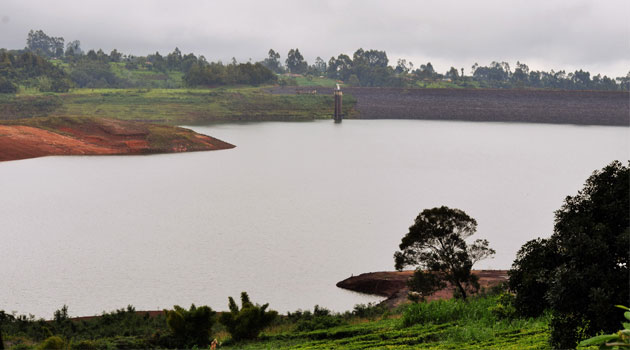
The pronouncement by CoG comes at a time Murang’a County has announced intent to claim 25 per cent of revenues collected by Nairobi County through distribution of water from Ndakaini dam, a water facility in Murang’a/FILE
NAIROBI, Kenya, Oct 26 – The ongoing debate over ownership and management of Water Services Providers (WSPs) has gained momentum after the Council of Governors insisted devolved units have exclusive freehold on management of water resources within their jurisdiction.
In a statement issued after an extraordinary meeting by county chiefs on Thursday, Council Chairperson Josphat Nanok said WSPs are fully owned by counties, a situation that can only be reversed through a constitutional amendment.
“Under the Fourth Schedule of the Constitution, the County Governments have the legal mandate of ownership and management of the WSPs within the counties. Counties have already legislated on this exclusive functions and this cannot be reversed short of their constitutional amendment,” the Turkana Governor asserted.
The pronouncement by CoG comes at a time Murang’a County has announced intent to claim 25 per cent of revenues collected by Nairobi County through distribution of water from Ndakaini dam, a water facility in Murang’a.
Nairobi relies on Ndakaini for over 80 per cent of its water supply needs.
Governor Mwangi wa Iria reiterated the stance on October 13 saying up to 30 per cent of Murang’a residents had no access to water despite having a dam within the county from which Nairobi draws water.
“I want to beseech the President and the Deputy President, like a child would ask his father, please give us water. Thirty per cent of my people (Murang’a residents) are short of water,” he stated during the burial of renowned musician Joseph Kamaru.
Following the appeal, President Uhuru Kenyatta promised to convene talks in order to resolve the matter saying Iria’s concerns were justified.
“Water is life. We must ensure Murang’a residents get water even as Nairobi residents do. Everyone must get their right and I have no doubt in my mind that we will find a lasting solution,” the Head of State undertook.
Under Part II of the Fourth Schedule of the Constitution, county governments are mandated to provide water and sanitation services as well as storm water management services in built-up areas.
It is based on the provision that the Murang’a County Assembly vowed in September to institute measures to ensure the county governments receives 25 per cent of revenues generated from selling water to Nairobi.
The Assembly threatened to disrupt the ongoing construction of the Sh6.8 billion Northern Collector Tunnel if the proposal is declined.
Water management has in the recent past evolved to become a thorny issue with inadequate rains precipitating of water shortages.
Diminishing water levels in Ndakaini had in the second quarter of the year triggered a water crisis in Nairobi forcing the City County to announce water rationing.
The situation improved late June when Governor Mike Sonko announced improved water levels (90 per cent) in Ndakaini.
Nairobi’s water demand is estimated to be about 770,000 cubic meters daily.
The county faces a daily water deficit of about 244,000 cubic meters given that city administration is only able to supply 526,000 cubic meters.
A similar situation is replicated nationwide, the country operation on a 350 cubic meter per capita water deficit annually
Studies put the current national water supply at 647 cubic meters per capita annually against a globally recommended threshold of 1,000 cubic meters per capita.
In March this year, the Ministry of Environment and Forestry announced plans to reforest an estimated 500,000 acres of land in water catchment areas to forestall a national water crisis in the near future.
The ministry also announced plans to double the country’s forest cover by 2022 from the current 7 per cent (official estimates) to 15 per cent.
The current estimate of national forest cover was published by the Kenya Natural Resources Alliance (KeNRA) in 2017, the agency reporting an improvement from 5.3 per cent in 2013.
Illegal logging and human settlements in government-listed forests however poses a threat to ongoing efforts to plant 235 million new seedlings by 2022.
Between 1990 and 2005, for instance, World Bank reported that Kenya lost an average of 12,600 hectares annually.
Data compiled by the Kenya National Bureau of Statistics based on the 2009 national census showed 65 per cent of the country’s population was dependent on wood for fuel, a situation that is seen as a catalyst to deforestation.
The National Government in February moved to address the imminent dangers posed by unregulated tree harvesting with Deputy President William Ruto declaring a 90-day moratorium on logging on.
“Deforestation, degradation, and encroachment of water towers and other catchment areas coupled with uncontrolled human activities including wanton logging have threatened and undermined our country’s capability to ensure food security,” Ruto said on February 24.
The government further extended the moratorium in May for a period of six months.
Kitui Governor Charity Ngilu instituted similar measures early this year banning the burning, selling, and transportation of charcoal within the county.
Under the Kitui County Charcoal Management Act (2014), the Eastern Kenya County established a Charcoal Management Committee which would vet and approve applications by charcoal producers.
The law sets a regulatory framework that required charcoal to be backed in bags with traceable codes to monitor contravention of laid down guidelines.
Under the law, the County Executive is empowered to revoke licenses issued to charcoal producers as well as monitor tree planting events by the Charcoal Producer Associations.








































